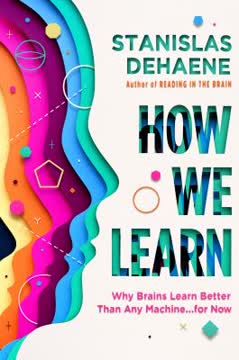Key Takeaways
1. The brain is a complex computer powered by billions of neurons
How can three pounds of tissue perform mental feats that outstrip the ability of the world's most powerful computers while consuming less energy than a dim lightbulb?
The brain as a biological computer. Unlike digital computers, the brain processes information in a highly parallel manner using billions of neurons. Neurons communicate through electrical and chemical signals, with neurotransmitters like dopamine playing key roles in learning and motivation. The brain's organization allows for both localized processing in specific regions and distributed processing across networks.
Key features of brain computation:
- Parallel processing across billions of neurons
- Localized functions in specific brain regions
- Distributed processing across neural networks
- Neurotransmitters like dopamine enabling learning and motivation
- Remarkable energy efficiency compared to digital computers
2. fMRI revolutionized our ability to study the living human brain
The success of fMRI relies upon a set of chemical and biological dominoes that all had to fall into place for it to have any chance of working, almost as if nature conspired to help make it just a bit easier for us to understand how the brain works.
The birth of fMRI. Functional magnetic resonance imaging (fMRI) was developed in the early 1990s, allowing researchers to observe brain activity non-invasively. It measures blood oxygenation level-dependent (BOLD) signals as a proxy for neural activity. This technique revolutionized cognitive neuroscience by enabling researchers to map brain function in living humans with unprecedented spatial resolution.
Key developments in fMRI:
- Measures blood oxygenation as a proxy for neural activity
- Non-invasive technique for studying human brain function
- Enables mapping of cognitive processes to brain regions
- Allows for studying complex mental states and disorders
- Continues to evolve with higher field strengths and new analysis methods
3. Brain decoding: Translating neural activity into mental states
Can we conclude from this data that the salmon is engaging in the perspective-taking task? Certainly not. What we can determine is that random noise in the [fMRI] timeseries may yield spurious results if multiple comparisons are not controlled for.
Decoding mental states. Brain decoding aims to infer mental content from patterns of brain activity. While early studies showed promise in decoding simple perceptual states, researchers have made progress in decoding more complex cognitive states. However, interpretation requires caution due to statistical challenges and the indirect nature of fMRI signals.
Advances and challenges in brain decoding:
- Successfully decoding visual perceptions and simple cognitive states
- Progress towards decoding more complex thoughts and intentions
- Statistical challenges like multiple comparisons must be addressed
- Indirect nature of fMRI signals limits precision of decoding
- Ethical concerns about privacy and potential misuse of mind-reading technology
4. Our brains are constantly changing through neural plasticity
Every experience you have leaves an imprint (however tiny) on the structure and function of your brain, through a set of brain mechanisms known as "neural plasticity."
Lifelong brain plasticity. The brain continues to change throughout life in response to experiences, learning, and environmental factors. This plasticity allows for adaptation and learning but also plays a role in mental disorders. Neuroimaging has revealed how experiences like musical training or drug use can alter brain structure and function over time.
Key aspects of neural plasticity:
- Synaptic changes strengthen connections between frequently co-activated neurons
- Structural changes in gray and white matter with learning and experience
- Rapid plasticity in response to injury or sensory deprivation
- Negative plasticity in addiction and some mental disorders
- Potential for harnessing plasticity in rehabilitation and treatment
5. Neuroimaging sheds light on mental illness and addiction as brain disorders
If mental illnesses are truly brain diseases then we should see evidence of them using brain imaging, and it should come as no surprise that a large number of studies have examined this question.
Brain-based understanding of mental illness. Neuroimaging has revealed structural and functional brain differences associated with mental disorders, supporting their classification as brain diseases. However, the relationship between brain changes and symptoms is complex. This research has implications for diagnosis, treatment, and reducing stigma around mental illness.
Neuroimaging findings in mental illness:
- Structural brain differences in disorders like schizophrenia and depression
- Functional alterations in brain networks associated with symptoms
- Overlap in brain changes across different diagnostic categories
- Evidence for addiction as a disorder of brain reward systems
- Potential for neuroimaging biomarkers to aid diagnosis and treatment selection
6. fMRI has limitations but continues to advance our understanding
Remember that fMRI is not listening directly to the neurons, but rather to the blood vessels that change in relation to the activity of neurons.
Limitations of fMRI. While fMRI has revolutionized brain research, it has important limitations. The BOLD signal is an indirect measure of neural activity with limited temporal and spatial resolution. Statistical challenges and potential artifacts require careful analysis and interpretation. Despite these limitations, fMRI continues to provide valuable insights into brain function.
Key limitations and considerations:
- Indirect measure of neural activity through blood flow changes
- Limited temporal resolution due to slow hemodynamic response
- Spatial resolution limited by vascular anatomy and field strength
- Statistical challenges in analyzing large, complex datasets
- Potential for artifacts from head motion and physiological noise
7. Ethical considerations arise as brain imaging capabilities grow
Can neuroimaging data provide a better way to validate claims of chronic pain? Potentially, but we are not there yet.
Ethical implications of neuroimaging. As brain imaging technologies advance, they raise important ethical questions. Potential applications in lie detection, pain assessment, and prediction of criminal behavior have significant legal and social implications. While these technologies show promise, their limitations and potential for misuse must be carefully considered.
Key ethical considerations:
- Use of fMRI for lie detection in legal settings
- Validating claims of chronic pain or other subjective experiences
- Predicting future criminal behavior based on brain scans
- Privacy concerns related to "mind-reading" technologies
- Potential for misuse or overinterpretation of brain imaging data
8. The future of neuroimaging: Higher resolution and new techniques
We are clearly just in the early infancy of neuroimaging, and there is no doubt that our ability to decode the mind will become radically more powerful in the coming years.
Advancing neuroimaging technology. The field of neuroimaging continues to evolve with higher field strength MRI scanners, new analysis techniques, and complementary methods like EEG and MEG. While fMRI will likely remain a key tool, researchers are exploring ways to overcome its limitations and develop new approaches for studying brain function.
Future directions in neuroimaging:
- Higher field strength MRI scanners (7T, 10.5T, and beyond)
- Advanced analysis methods like multivariate pattern analysis
- Combining fMRI with other modalities (EEG, MEG, PET)
- Development of new contrast mechanisms beyond BOLD
- Potential for real-time neurofeedback and brain-computer interfaces
Last updated:
FAQ
What's The New Mind Readers about?
- Exploration of Neuroimaging: The book examines how neuroimaging techniques, especially fMRI, allow scientists to visualize brain activity and understand cognitive functions.
- Mind Reading Concept: It discusses the potential and limitations of "mind reading" by decoding brain activity, highlighting both the power and constraints of these technologies.
- Broader Implications: Russell A. Poldrack addresses philosophical questions about consciousness and decision-making, and the implications of neuroimaging in mental illness and criminal justice.
Why should I read The New Mind Readers?
- Cutting-Edge Science: The book offers insights into the latest advancements in neuroscience, reshaping our understanding of the human mind.
- Interdisciplinary Approach: It combines neuroscience with psychology, ethics, and law, appealing to readers interested in multiple fields.
- Thought-Provoking Questions: Poldrack raises questions about identity, responsibility, and consciousness, encouraging critical thinking about scientific discoveries.
What are the key takeaways of The New Mind Readers?
- Neuroimaging's Power and Limits: While neuroimaging can reveal brain activity linked to thoughts and feelings, it cannot definitively interpret those thoughts.
- Brain as a Complex System: The brain functions as an integrated network, challenging simplistic views of brain localization.
- Ethical Considerations: The book discusses the ethical implications of using neuroimaging in legal contexts, especially concerning juvenile justice and mental illness.
What are the best quotes from The New Mind Readers and what do they mean?
- Complexity of the Brain: "Understanding how the brain works is almost certainly the most challenging scientific problem of our time." This highlights the brain's complexity and the ongoing quest to unravel its mysteries.
- Biological View of Thought: "If thinking is just a biological function that we can visualize with MRI, then what becomes of the mystery of human consciousness?" This challenges readers to consider the essence of consciousness.
- Interpreting Neuroimaging Data: "There is no simple one-to-one mapping between psychological states and activity in specific brain areas." This cautions against oversimplified interpretations of neuroimaging data.
How does fMRI work according to The New Mind Readers?
- Blood Flow Measurement: fMRI measures changes in blood flow related to neural activity, as active brain regions require more oxygenated blood.
- BOLD Signal: It relies on the Blood Oxygen Level Dependent (BOLD) contrast, detecting variations in blood oxygenation levels to infer brain activity.
- Spatial and Temporal Resolution: fMRI provides high spatial resolution images but has limitations in temporal resolution, capturing where activity occurs but not precisely when.
What are the limitations of neuroimaging discussed in The New Mind Readers?
- Reverse Inference Problem: Inferring specific thoughts or feelings from brain activity is problematic, as different mental states can activate the same brain regions.
- Generalizability Issues: Neuroimaging findings often do not generalize well across individuals, complicating universal application of results.
- Ethical Concerns: Potential misuse in legal contexts raises ethical questions about privacy, consent, and brain data interpretation.
How does The New Mind Readers address mental illness?
- Brain Disease Perspective: Poldrack discusses whether mental illnesses should be viewed strictly as brain diseases, advocating for a nuanced understanding.
- Neuroimaging Insights: The book highlights how neuroimaging has identified brain dysfunctions associated with conditions like depression and anxiety.
- Implications for Treatment: Understanding the brain's role in mental illness can inform treatment approaches, but oversimplification of these conditions is cautioned against.
What is the significance of the "default mode network" in The New Mind Readers?
- Resting State Activity: The default mode network shows increased activity when a person is at rest, often linked to introspective thought.
- Cognitive Functions: It is involved in self-referential thinking, memory retrieval, and future planning.
- Individual Variability: The network's organization varies significantly between individuals, highlighting the need for personalized approaches in neuroscience.
How does The New Mind Readers relate neuroimaging to decision-making?
- Decision Neuroscience: Neuroimaging has advanced understanding of neural mechanisms underlying decision-making, including risk assessment and reward evaluation.
- Dopamine's Role: Dopamine is crucial for signaling prediction errors, essential for learning and adaptive decisions.
- Implications for Behavior: Insights into decision-making processes inform fields like marketing and behavioral economics, raising ethical questions about manipulation.
What future directions for neuroimaging does Poldrack suggest in The New Mind Readers?
- Technological Advancements: New techniques could overcome current limitations, such as improved temporal resolution and capturing dynamic brain processes.
- Integration with Other Data: Combining neuroimaging with genetic, behavioral, and environmental data could create a comprehensive understanding of brain function.
- Personalized Neuroscience: Future neuroimaging may involve personalized approaches, allowing tailored interventions based on individual brain characteristics.
What are the ethical implications of neuroimaging discussed in The New Mind Readers?
- Legal Applications: The use of neuroimaging in legal contexts, like lie detection, raises concerns about reliability and ethical implications.
- Privacy Concerns: Neuroimaging could infringe on personal privacy, revealing sensitive information about thoughts and intentions.
- Stigmatization of Mental Illness: Labeling mental disorders as brain diseases may reduce stigma but could also lead to negative perceptions of individuals with mental health issues.
How does the author suggest improving neuroimaging research in The New Mind Readers?
- Transparency in Research: Poldrack advocates for open data sharing to enhance reproducibility and collaboration, building trust in research findings.
- Preregistration of Studies: Emphasizing preregistration of methods and hypotheses prevents questionable research practices, ensuring rigorous studies.
- Combining Techniques: Integrating different neuroimaging methods could provide a comprehensive understanding of brain function, overcoming individual technique limitations.
Review Summary
The New Mind Readers receives mixed reviews, with an average rating of 3.89/5. Readers appreciate its overview of fMRI technology and neuroimaging, praising the author's commitment to science and impartial approach. Some find it informative and accessible, while others consider it too technical for lay readers or not novel enough for experts. The book is commended for addressing current issues in neuroscience and providing historical context. However, some reviewers note that it may lack depth in certain areas and criticize its focus on individual researchers rather than collaborative efforts.
Similar Books
Download PDF
Download EPUB
.epub digital book format is ideal for reading ebooks on phones, tablets, and e-readers.










